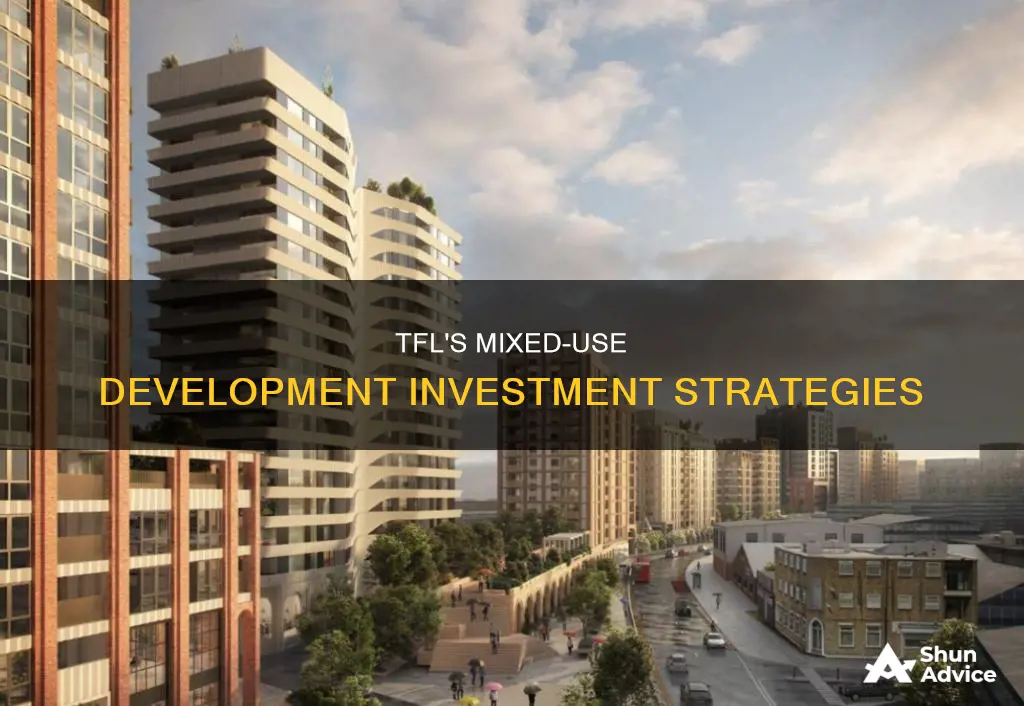
Transport for London (TfL) is one of London's largest landowners, owning a 5,700-acre estate with land and properties that can be used to create homes and jobs. In addition to being responsible for over 30 million journeys daily, TfL has outlined plans to develop its sites for mixed-use purposes, including housing, commercial spaces, and transport infrastructure. By working with developers and local authorities, TfL aims to build communities around transport hubs, generate revenue, and reinvest in the city's transport network. One notable example is the agreement between TfL and Aviva Investors to construct a mixed-use retail and office building at 1 Liverpool Street in the City of London.
| Characteristics | Values |
|---|---|
| Number of homes | 80 expected in Southwark Street site, 348 in Hounslow West, 351 in Cockfosters, and 20,000 planned over the next 10 years |
| Proportion of affordable housing | 50% across all sites, with 40% in Cockfosters and 35% in Southwark Street |
| Commercial space | 130,000 sq ft of commercial, retail, and workspace in Southwark Street, 175,000 sq ft of office and retail space at 1 Liverpool Street |
| Transport links | Close to Hounslow West Tube station, Cockfosters Underground station, and the new Liverpool Street Elizabeth line eastern station entrance |
| Environmental considerations | The Cross Bones Graveyard, a historic graveyard, will be safeguarded; the Hounslow West development will be car-free |
| Construction partners | Triangle London Developments, Aviva Investors, A2Dominion |
What You'll Learn

TfL's mixed-use development plans
Transport for London (TfL) has outlined its development plans for mixed-use sites across London, including the creation of new homes, commercial spaces, and improvements to transport infrastructure. As one of London's largest landowners, TfL owns a 5,700-acre estate with significant potential for development.
TfL's plans include the development of a site in Southwark Street into a mixed-use "cultural and social hub". The site is expected to include around 80 new homes, with at least 35% being affordable, as well as 130,000 sq ft of commercial, retail, and workspace. TfL has also announced a development agreement with Aviva Investors to construct a mixed-use retail and office building at 1 Liverpool Street in the City of London. This building will offer approximately 175,000 sq ft of office and retail space.
In addition to these projects, TfL has set up a dedicated, self-financing property company, Transport Trading Limited Properties (TTLP), with the aim of delivering 20,000 new homes over the next ten years. TTLP has already started building 1,700 homes, with a further 2,400 scheduled to begin construction this year. TTLP's objectives include paying a dividend to TfL to reduce subsidies, developing housing in line with GLA objectives, and making operational improvements such as electrifying bus depots.
To release its sites, TfL is utilising several routes, including property partnerships with leading developers, direct development, and site-specific partnerships. They are also planning to release their smaller sites. Through these initiatives, TfL aims to create homes and communities around transport hubs, providing convenient and sustainable living and working environments for Londoners.
Smart Ways to Invest Your Cash Wisely
You may want to see also

The role of property partnerships
Transport for London (TfL) is one of London's largest landowners, owning a 5,700-acre estate with land and properties that can be developed to meet the city's housing and job needs. To realise the potential of its landholdings, TfL has established property partnerships with leading developers to deliver thousands of homes, offices, and retail spaces.
The chosen partners were selected through a competitive process, with over 50 companies expressing interest. The successful organisations were appointed based on their experience in delivering complex and mixed-use schemes. By working with these leading developers, TfL can leverage their expertise and resources to bring forward much-needed developments more efficiently.
The Property Partnership programme is an integral part of TfL's strategy to generate £3.4 billion in non-fares commercial revenue by 2023, which will be reinvested in London's transport network. It also aligns with the Mayor's priorities to build affordable homes and improve transport infrastructure. By working with property partners, TfL can access their knowledge, networks, and capabilities to maximise the impact of its development initiatives.
In addition to the 13 property partners, TfL also engages in direct development and site-specific partnerships to release its sites. This collaborative approach allows TfL to access a diverse range of expertise and resources, ensuring that its development projects are well-supported and have a greater chance of success.
Depreciation's Impact on Cash Flow: Investing Activities
You may want to see also

Funding and revenue generation
Transport for London (TfL) is one of London's largest landowners, owning a 5,700-acre estate with land and properties that can be developed to create the homes and jobs that the capital needs. This includes a focus on building affordable homes to meet the Mayor's priorities, while also generating revenue to invest in improving the transport network.
TfL has outlined plans to deliver 10,000 homes across 300 acres, with half of its sites being affordable. They are also working on new commercial spaces, station enhancements, and wider public realm improvements. To release their sites, they are utilising their property partnerships framework, which includes 13 leading developers, as well as direct development and site-specific partnerships.
In 2021, TfL proposed the creation of a "dedicated, self-financing property company" called Transport Trading Limited Properties (TTLP) to deliver housing as part of a funding package with the government. TTLP became financially separate from TfL in April 2022 and has raised £200 million in secured debt to fund commercially viable projects across 5,000 acres. It aims to deliver 20,000 new homes over the next ten years, with 50% being affordable housing.
TTLP has three main objectives:
- To pay a dividend to TfL to help reduce subsidies
- Develop housing in line with GLA objectives
- Make operational improvements such as electrifying bus depots
TfL has also entered into agreements with developers for commercial complexes around new Crossrail stations, such as their agreement with Aviva Investors to construct a mixed-use retail and office building at 1 Liverpool Street. These developments are expected to raise vital revenue to reinvest in London's transport network.
In addition to these projects, TfL is seeking a joint venture partner to create a portfolio of three new commercial office developments at Bank, Paddington, and Southwark. They are also involved in the regeneration of the former Earls Court Exhibition Centre site in West London, a 40-acre project being led by the Earls Court Development Company.
Investing Activities: Do Cash Flows Stay Positive?
You may want to see also

Sustainability and environmental impact
Transport for London (TfL) has a huge impact on the sustainability and environmental landscape of the city. As one of London's largest landowners, with a 5,475-5,700-acre estate, TfL has the potential to create much-needed homes and jobs in the capital.
TfL's development plans are designed with sustainability in mind. Their Sustainable Development Framework guides their property development to make London cleaner and greener. Their development partners must adhere to Design Principles and Environmental Principles, ensuring that sustainability is at the core of their projects.
One example of their commitment to sustainability is the Landmark Court site in Southwark Street. This mixed-use development, in partnership with Triangle London Developments, will create a "cultural and social hub" with 80 new homes, 35% of which will be affordable. The site will also offer 130,000 sq ft of commercial, retail, and workspace, maximising outdoor public space and improving walking routes. The historic Cross Bones Graveyard, a burial site for prostitutes and paupers, will be protected as part of the development.
Another project, in collaboration with Aviva Investors, involves the construction of a mixed-use retail and office building at 1 Liverpool Street. This development will provide 175,000 sq ft of space and is located above the Crossrail infrastructure. These projects not only support the city's growth but also raise vital revenue to reinvest in London's transport network, contributing to the sustainability of the city's infrastructure.
TfL's property developments also focus on enhancing stations and the wider public realm. They aim to build communities around transport hubs, making it easier for residents to live and work sustainably. For instance, the development near Hounslow West Tube station provides easy access to public transport and cycling, with residential cycle spaces and a car-free design.
Overall, TfL's investment in mixed-use developments considers sustainability and environmental impact by creating affordable housing, generating revenue for transport improvements, enhancing public spaces, and promoting sustainable transport options.
Cash Investments: Now or Later?
You may want to see also

Community engagement and social impact
Transport for London (TfL) is committed to high-quality public and community engagement throughout the lifetime of any development site it brings forward. It has an in-house team and works with specialist consultants in community engagement. Each scheme has a bespoke project website providing the latest information on the scheme, including contact details for the project team.
TfL's community engagement efforts are underpinned by a framework of guiding principles, strategies, and approaches. This framework is based on principles that respect the right of all community members to be informed, consulted, involved, and empowered. Fostering and enhancing trust is critical to long-term, sustainable engagement and effective governance.
TfL's community engagement strategies are sensitive to the community context in which they occur. For example, in the case of the South Kensington station development, TfL has been working with the local community to draw up plans for new shops, homes, and office spaces around the station.
TfL's mixed-use development projects contribute to social impact by creating vibrant communities that support diverse activities and reduce the need for long commutes. By allowing different types of uses in proximity, mixed-use developments can enhance social interactions, economic vitality, and environmental sustainability.
For instance, the Wood Lane Arches project in Hammersmith & Fulham involves transforming 31 disused railway arches underneath Wood Lane Tube station into new commercial units for retail and workspaces, with amenities and cycle parking. This project supports the regeneration of the White City Opportunity Area by creating direct routes between White City Living and Westfield London, enhancing social interaction and providing convenient access to amenities.
Another example is the Blackhorse View project in Waltham Forest, where TfL is transforming a car park into 350 homes, 50% of which are affordable. This development will also bring new shops, restaurants, cafes, and public spaces to the area, contributing to a more diverse and vibrant community.
Investing Cash Flow: Exploring Other Items
You may want to see also
Frequently asked questions
TfL has partnered with Aviva Investors to construct a mixed-use retail and office building at 1 Liverpool Street in the City of London. The building will offer around 175,000 sq ft of office and retail space. Additionally, TfL has collaborated with Triangle London Developments to transform the Landmark Court site in Southwark Street into a mixed-use development, including around 80 homes and 130,000 sq ft of commercial, retail, and workspace areas. These projects will generate revenue to reinvest in improving London's transport network.
TfL's investment in mixed-use development serves multiple purposes. Firstly, it aims to create new homes, jobs, and workspaces that London needs. By developing these sites, TfL can play a vital role in meeting the Mayor's priorities to build affordable homes. Additionally, these projects will generate revenue that can be reinvested in improving and expanding London's transport network.
TfL's investment in mixed-use development offers several benefits. Firstly, it helps to create much-needed housing, with a focus on providing a significant portion of affordable homes. Secondly, it generates revenue that can be used to reinvest in London's transport network, leading to improvements and expansion. Additionally, these developments enhance stations and public realm improvements, creating vibrant communities around transport hubs where people want to live and work.







